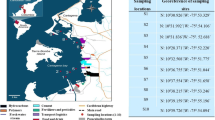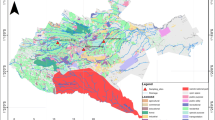Abstract
This study was conducted to determine the status and trends of organochlorine pesticide (OCP) compounds in the sediment and mussel samples collected along the Istanbul Strait and from the coasts of an island in the Marmara Sea. The total concentrations of OCPs were found in the range of 40–13,852 pg g − 1 dry weight for sediments and 5,195–12,322 pg g − 1 wet weight for mussels. The levels of OCPs in both sediments and mussels were dominated by DDTs and HCHs; β-HCH, 4,4′-DDD and 4,4′-DDE were the major pollutants. The degree of sediment pesticide contamination was more severe in the inner part of the strait. OCP concentrations in sediments and mussels were compared with the sediment guideline values and legal limits for human health, respectively. The results showed that OC pesticide contamination in the strait might not pose a serious threat to the health of the marine inhabitants at most of the stations.
Similar content being viewed by others
References
ATSDR (Agency for Toxic Substances and Disease Registry) (2002). Toxicological profile for DDT, DDE, DDD. Atlanta, GA: US Department of Health and Human Services, Public Health Service. www.atsdr.cdc.gov. Accessed 20 May 2009.
Bakan, G., & Ariman, S. (2004). Persistent organochlorine residues in sediments along the coast of mid Black Sea Region of Turkey. Marine Pollution Bulletin, 48, 1031–1039.
Barakat, A. O., Kim, M., Qian, Y., & Wade, T. L. (2002). Organochlorine pesticides and PCB residues in sediments of Alexandria harbour, Egypt. Marine Pollution Bulletin, 44, 1421–1434.
Burns, K., & Villeneuve, J. P. (1987). Chlorinated hydrocarbons in the open Mediterranean ecosystem and implications for mass balance calculation. Marine Chemistry, 20, 337–359.
Chase, M. E., Jones, S. H., Hennigar, P., Sowles, J., Harding, G. C. H., Freeman, K., et al. (2001). Gulfwatch: Monitoring spatial and temporal patterns of trace metal and organic contaminants in the gulf of Maine (1991–1997) with the blue mussel, Mytilus edulis L. Marine Pollution Bulletin, 42, 491–505.
Claisse, D. (1989). Chemical contamination of French coast. The results of ten year mussel watch. Marine Pollution Bulletin, 20, 523–528.
Dannenberd, D. (1996). Chlorinated microcontaminants in surface sediments of Baltic Sea—investigations in the Belt Sea, the Arkona Sea and Pomernian Bight. Marine Pollution Bulletin, 32, 772–781.
de Mora, S., Villeneuve, J.-P., Sheikholeslami, M. R., Cattini, C., & Tolosa, I. (2004). Organochlorinated compounds in Caspian Sea sediments. Marine Pollution Bulletin, 48, 30–43.
Doong, R. A., Sun, Y. C., Liao, P. L., Peng, C. K., & Wu, S. C. (2002). Distribution and fate of organochlorine pesticide residues in sediments from the selected rivers in Taiwan. Chemosphere, 48, 237–246.
Draft Risk Profile for pentachlorobenzene (2007). Stockholm convention on persistent organic pollutants. Persistent Organic Pollutants Review Committee (POPRC).
Fillmann, G., Readman, J. W., Tolosa, I., Bartocci, J., Villeneuve, J. P., Cattini, C., et al. (2002). Persistent organochlorine residues in sediments from Black Sea. Marine Pollution Bulletin, 44, 122–133.
Fowler, S. W. (1990). Critical review of selected heavy metals and chlorinated hydrocarbons concentrations in the marine environment. Marine Environmental Research, 29, 1–64.
Fung, C. N., Zheng, G. J., Connell, D. W., Zhang, X., Wong, H. L., Giesy, J. P., et al. (2005). Risks posed by trace organic contaminants in coastal sediments in the Pearl River Delta, China. Marine Pollution Bulletin, 50, 1036–1049.
Galanopoulou, S., Vgenopoulos, A., & Conispoliatis, N. (2005). DDTs and other chlorinated organic pesticides and polychlorinated biphenyls pollution in the surface sediments of Keratsini harbour, Saronikos Gulf, Greece. Marine Pollution Bulletin, 50, 520–525.
Hites, R. K., & Day, H. R. (1992). Unusual persistence of DDT in some Western USA soils. Bulletin of Environmental Contamination and Toxicology, 48, 259–264.
Hong, H., Xu, L., Zhang, L., Chen, J. C., Wong, Y. S., & Wan, T. S. M. (1995). Environmental fate and chemistry of organic pollutants in the sediment of Xiamen Harbor and Victoria Harbor. Marine Pollution Bulletin, 31, 229–236.
Hong, S. H., Yim, U. H., Shim, W. J., Li, D. H., & Oh, J. R. (2006). Nationwide monitoring of polychlorinated biphenyls and organochlorine pesticides in sediments from coastal environment of Korea. Chemosphere, 64, 1479–1488.
Iwata, H., Tanabe, S., Ueda, K., & Tatsukawa, R. (1995). Persistent organochlorine residues in air, water, sediments, and soils from the Lake Baikal region, Russia. Environmental Science and Technology, 29, 792–801.
Jiang, X., Martens, D., Schramm, K.-W., Kettrup, A., Xu, S. F. & Wang, L. S. (2000). Polychlorinated organic compounds (PCOCs) in waters, suspended solids and sediments of the Yangtse River. Chemosphere, 41, 901–905.
Karacık, B., Okay, O. S., Henkelmann, B., Bernhöft, S., & Schramm, K.-W. (2009). Polycyclic aromatic hydrocarbons and effects on marine organisms in the Istanbul Strait. Environment International, 35, 599–606.
Khaled, A., El Nemr, A., Said, T. O., El-Sikaily, A., & Abd-Alla, A. M. A. (2004). Polychlorinated biphenyls and chlorinated pesticides in mussels from the Egyptian Red Sea coast. Chemosphere, 54, 1407–1412.
Khim, J. S., Villeneuve, D. L., Kannan, K., Hu, W. Y., Giesy, J. P., Kang, S.-G., et al. (2000). Instrumental and bioanalytical measures of persistent organochlorines in blue mussel (Mytilus edulis) from Korean coastal waters. Archives of Environmental Contamination and Toxicology, 39, 360–368.
Kolankaya, D. (2006). Organochlorine pesticide residues and their toxic effects on the environment and organisms in Turkey. International Journal of Environmental Analytical Chemistry, 86, 147–160.
Kurt, P. B., & Ozkoc, H. B. (2004). A survey to determine levels of chlorinated pesticides and PCBs in mussels and seawater from the mid-Black Sea coast of Turkey. Marine Pollution Bulletin, 48, 1076–1083.
Loganathan, B. G., Sajwan, K. S., Richardson, J. P., Chetty, C. S., & Owen, D. A. (2001). Persistent organochlorine concentrations in sediment and fish from Atlantic coastal and brackish waters off Savannah, Georgia, USA. Marine Pollution Bulletin, 42, 246–250.
NOAA (1999). Screening quick reference tables. http://response.restoration.noaa.gov/book_shelf/122_squirt_cards.pdf. Accessed 20 May 2009.
O’Connor, T. P., & Beliaeff, B. (1995). Recent trends in coastal environmental quality: Results from the Mussel Watch Project. NOS ORCA Spec. Pub. NOAA/NOS/ORCA (p. 40). MD: Silver Spring.
Okay, O. S., Pekey, H., Morkoç, E., Başak, S., & Baykal, B. (2008). Metals in the surface sediments of Istanbul Strait (Turkey). Journal of Environmental Science and Health Part A, 43, 1725–1734.
Okay, O. S., Karacık, B., Henkelmann, B., Bernhöft, S., & Schramm, K.–W. (2009). PCB and PCDD/F in sediments and mussels of the Istanbul Strait (Turkey).Chemosphere, 76, 159–166.
Özbek, F. Ş., & Fidan, H. (2009). Estimation of pesticides usage in the agricultural sector in Turkey using artificial neural network (ANN). Journal of Animal and Plant Sciences, 4, 373–378.
Perugini, M., Cavaliere, M., Giammarino, A., Mazzone, P., Olivieri, V., & Amorena, M. (2004). Levels of polychlorinated biphenyls and organochlorine pesticides in some edible marine organisms from the Central Adriatic Sea. Chemosphere, 57, 391–400.
Pikkarainen, A.-L. (2007). Polychlorinated biphenyls and organochlorine pesticides in Baltic Sea sediments and bivalves. Chemosphere, 68, 17–24.
Ramesh, A., Tanabe, S., Murase, H., Subramanian, A. N., & Tatsukawa, R. (1991). Distribution and behaviour of persistent organochlorine insecticides in paddy soil and sediments in the tropical environment: A case study in South India. Environmental Pollution, 74, 293–307.
Richardson, B. J., Tse, E. S.-C., De Luca-Abbott, S. B., Martin, M., & Lam, P. K. S. (2005). Uptake and depuration of PAHs and chlorinated pesticides by semi-permeable membrane devices (SPMDs) and green-lipped mussels (Perna viridis). Marine Pollution Bulletin, 51, 975–993.
Sarkar, S. K., Bhattacharya, B. D., Bhattacharya, A., Chatterjee, M., Alam, A., Satpathy, K. K., et al. (2008). Occurrence, distribution and possible sources of organochlorine pesticide residues in tropical coastal environment of India: An overview. Environment International, 34, 1062–1071.
Schumacher, B. A. (2002). Methods for the determination of total organic carbon (TOC) in soils and sediments. United States Environmental Protection Agency Environmental Sciences Division National Exposure Research Laboratory, Ecological Risk Assessment Support Center Office of Research and Development, NCEA-C-1282 EMASC-001.
Sericano, J. L., Wade, T. L., Jackson, T. J., Brooks, J. M., Tripp, B. W., Farrington, J. W., et al. (1995). Trace organic contamination in the Americas: An overview of the US national status and trends and the international “Mussel Watch” programmes. Marine Pollution Bulletin, 31, 214–225.
Serrano, R., Hernandez, F., Pena, J. B., Dosda, V., & Canales, J. (1995). Toxicity and bioconcentration of selected organophosphorus pesticides in Mytilus galloprovincialis and Venus gallina. Archives of Environmental Contamination and Toxicology, 29, 284–290.
Siriwong, C., Hironaka, H., Onodera, S., & Tabucanon, S. M. (1991). Organochlorine pesticide residues in green mussel (Perna viridus) from the Gulf of Thailand. Marine Pollution Bulletin, 22, 510–516.
Sole, M., Porte, C., Barcelo, D., & Albaiges, J. (2000). Bivalves residue analysis for the assessment of coastal pollution in the Ebro Delta (NW Mediterranean). Marine Pollution Bulletin, 40, 746–753.
State Planning Organization (2008). Fertilizer and pesticides working group report of chemical industry specialized commission. Prime Ministry, Republic of Turkey (in Turkish).
Telli, F. (1991). Seasonal changes in the polycyclic aromatic hydrocarbons (PAHs) and organochlorine pesticide levels in mussels living along the Black Sea. MSc thesis, Department of Marine Biology and Fisheries Institute of Marine Sciences, Middle East Technical University.
Tolosa, I., Bayona, J. M., & Albaiges, J. (1995). Spatial and temporal distribution, fluxes and budgets of organochlorinated compounds in NW Mediterranean sediments. Environmental Science and Technology, 29, 2519–2527.
Tuncer, G., Karakas, T., Balkas, T. I., Gokcay, C. F., Aygun, S., Yurteri, C., et al. (1998). Land-based sources of pollution along the Black Sea coast of Turkey: Concentrations and annual loads to the Black Sea. Marine Pollution Bulletin, 36, 409–423.
U.S. EPA (2000). Guidance for assessing chemical contaminant data for use in fish advisories (3rd ed.). Fish sampling and analysis (Vol. 1). EPA 823-B-00-007.
U.S. Food and Drug Administration (1995). Fish and fishery products hazards and controls guide (2nd ed.). Rockville: Center for Food Safety and Applied Nutrition, US Food and Drug Administration.
van-Birgelen, A. P. J. M. (1998). Hexachlorobenzene as a possible major contributor to the dioxinactivity of human milk. Environmental Health Perspectives, 106, 683–688.
Villeneuve, J. P., Carvalho, F. P., Fowler, S. W., & Cattini, C. (1999). Levels and trends of PCBs, chlorinated pesticide and petroleum hydrocarbons in mussels from the NW Mediterranean coast: Comparison of concentration in 1973/1974 and 1988/1989. Science of Total Environment, 237/238, 57–65.
Voorspoels, S., Covaci, A., Maervoet, J., De Meester, I., & Schepens, P. (2004). Distribution of PCBs/OCPs in benthic organisms and fish from the North Sea continental shelf and Scheldt estuary. Marine Pollution Bulletin, 49, 393–404.
Wang, Y., Yang, R., & Guibin, J. (2007). Investigation of organochlorine pesticides (OCPs) in mollusks collected from coastal sites along the Chinese Bohai Sea from 2002 to 2004. Environmental Pollution, 146, 100–106.
Wu, W., Xu, Y., Schramm, K.-W., & Kettrup, A. (1997a). Study of sorption, biodegradation and isomerization of HCH in stimulated sediment/water system. Chemosphere, 35, 1887–1894.
Wu, W. Z., Schramm, K. W., Henkelmann, B., Xu, Y., Yediler, A., & Kettrup, A. (1997b). PCDD/Fs, PCBs, HCHs and HCB in sediments and soils of Ya-er Lake area in China: Results on residual levels and correlation to the organic carbon and the particle size. Chemosphere, 34, 191–202.
Zhang, Z. L., Hong, H. S., Zhou, J. L., Huang, J., & Yu, G. (2003). Fate and assessment of persistent organic pollutants in water and sediment from Minjiang River estuary, Southeast China. Chemosphere, 52, 1423–1430.
Zeng, E. Y., & Venkatesan, M. I. (1999). Dispersion of sediment DDTs in the coastal ocean off Southern California. Science of Total Environment, 229, 195–208.
Zhou, R., Zhu, L., & Kong, Q. (2008). Levels and distribution of organochlorine pesticides in shellfish from Qiantang River, China. Journal of Hazardous Materials, 152, 1192–1200.
Author information
Authors and Affiliations
Corresponding author
Rights and permissions
About this article
Cite this article
Okay, O.S., Karacık, B., Henkelmann, B. et al. Distribution of organochlorine pesticides in sediments and mussels from the Istanbul Strait. Environ Monit Assess 176, 51–65 (2011). https://doi.org/10.1007/s10661-010-1566-5
Received:
Accepted:
Published:
Issue Date:
DOI: https://doi.org/10.1007/s10661-010-1566-5




